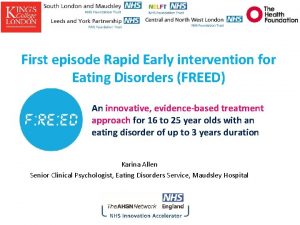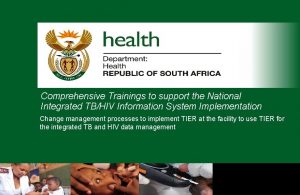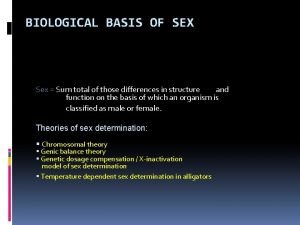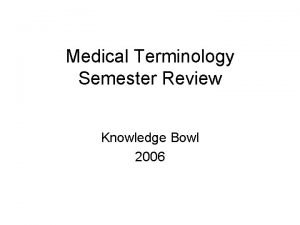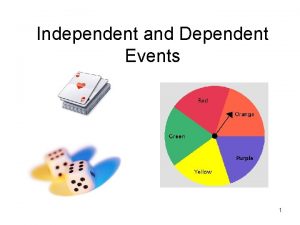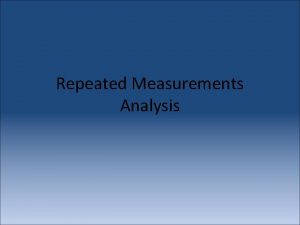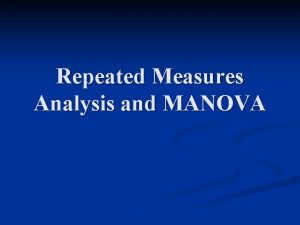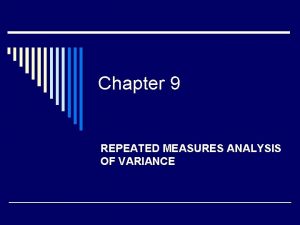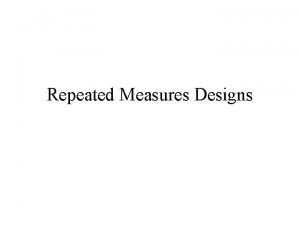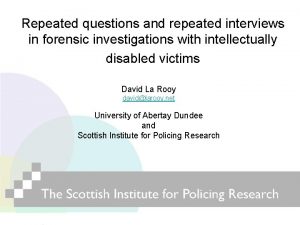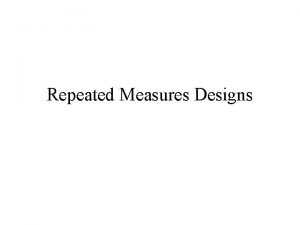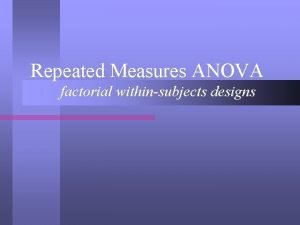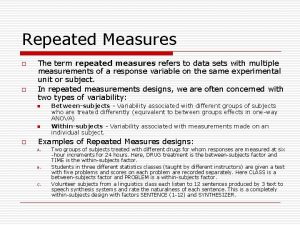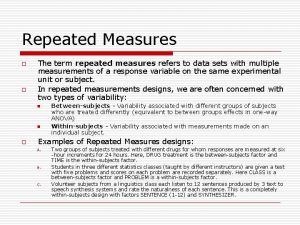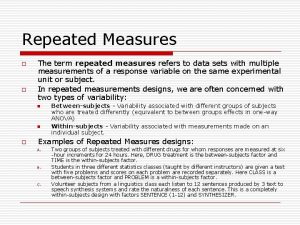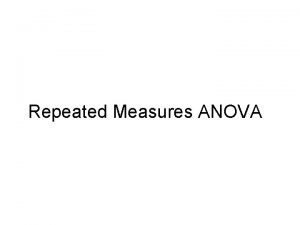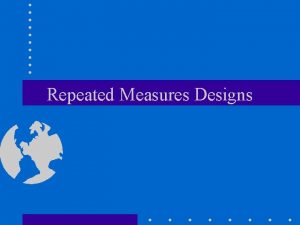TIME TO EVENT ANALYSIS FOR REPEATED PAIN EPISODES

























- Slides: 25

TIME TO EVENT ANALYSIS FOR REPEATED PAIN EPISODES USING FRAILTY MODELS Pro gradu –thesis Tuija Hevonkorpi

Contents � � � Basic of survival analysis Weibull model Frailty models Accelerated failure time model Case study

Basics of survival analysis � � Analysis of data from a given time origin until occurence of a specific point in time Two main difficulties: Observed survival time are often incomplete Specifying the true survival time

Basics of survival analysis Censoring � � � Occurs when the favoured endpoint is not observed Complicates the exact distribution theory and the estimation of quantiles Special statistical models and methods for analysing data arises

Basics of survival analysis Survival time � � Moment in time when the patient was recruited until endpoint occurs Only calculated for those who encounter the endpoint Survivor function summarises the distribution of the survival times Censoring time and survival time are statistically independent random variables

Basics of survival analysis Survival time

Basics of survival analysis Survivor function Describes patient´s probability to survive from the time origin t 0 over a specific time t. The probability that survival time is less than t is described with the distribution function of T, F(t).

Basics of survival analysis Hazard function The approximate probability for a patient encountering the endpoint in the next point in time ti+1, on condition that the endpoint has not been encountered at time ti Connection b/w the hazard and the survivor function can be easily made , where

Basics of survival analysis Summary � Useful connections between the functions used in the analysis of survival data

Weibull model � � � Survivor function of the Weibull distribution is at the same time a proportional hazards model and an accelerated failure time (AFT) model Mathematically easy to handle Characterised by the scale, , and the shape, , parameter The hazard function: , for 0≤ t < ∞ The proportional hazards model for a patient i is

Weibull model hazard decreases monotonically hazard increases monotonically reduces to constant exponential hazard

Frailty models � � Often survival times are not independent More than one endpoint occuring for one patient – repeated event times within a patient The random effect is refered to as frailty Frailty is unobserved variation between patients - the most frail encounter the endpoint earlier than those not so frail

Accelerated failure time model – AFT model � � � An alternative way to model failure time data Hazard function does not have to follow a specific distribution Regression parameters are robust towards the neglected covariates Best described by the survivor function The per cent of patients in the group A that live longer than t, is equal to the per cent of patients in the group B that live longer than t The survival time is speeded up or slowed down by the effect of the explanatory variable

Case study � � Main objective is to evaluate the time to significant pain relief with the active medication group compared to placebo group Three models: • A proportional hazards model with Weibull distributed event times and gamma frailty term • A proportional hazards model with Weibull distributed event times and log-normal frailty term • An AFT model with log-normal distributed event times and log-normal frailty term

Case study Pain episode Treatment group N % First Placebo 30 25. 21 Active 89 74. 79 Placebo 29 25. 66 Active 84 74. 34 Second � � Patients were randomised in 3: 1 ratio in the two treatment groups 113 patients experienced two pain episodes, 6 patients only one.

Case study Pain episode First Treatment group Placebo Active Time to pain relief N % 5 min 12 54. 44 10 min 5 22. 73 15 min 4 18. 18 20 min 1 4. 55 5 min 36 56. 25 10 min 17 26. 56 15 min 6 9. 38 20 min 3 4. 69 30 min 2 3. 13

Case study Model with gamma frailty � The model for the log-likelihood function with gamma frailty effect which in the NLMIXEDprocedure can be written for patient i as

Case study Model with gamma frailty � Kaplan-Meier estimate and the population survivor function for the two treatment groups separately

Case study Model with gamma frailty � The population survivor function is calculated as � The subject specific estimated survivor functions are obtained from where ui is the predicted frailty term and H 0(t) the Weibull baseline hazard,

Case study Model with gamma frailty � Individual and population survivor function estimate for the active treatment group

Case study Model with log-normal frailty � � � There is no explicit form for the marginal likelihood Instead of integrating out the frailty, numerical integration is done using the NLMIXED-procedure in SAS software The log-likelihood function is of from

Case study AFT model with frailty � � AFT model with log-normally distributed event times and log-normal frailty term The log-likelihood function is where is , in where the cumulative distribution function of the standard normal distribution.

Case study AFT model with frailty � The functions cross because different treatment is given to different patients when the usual reparametrisation of the survivor function of the AFT model does not occur necessary

Case study Discussion Model - 2 log-likelihood AIC No frailty 1408. 7 1416. 7 Gamma frailty 1199. 6 1207. 6 Log-normal frailty 1251. 0 1259. 0 AFT model with frailty 1250. 5 1258. 5 § All but log-normal frailty and AFT with frailty differ from each other statistically significantly § In all analyses, the hazard ratio, or the accelerator factor in AFT model, was calculated, and the difference between the two models was not statistically significant

Questions?
 5 w's of event management
5 w's of event management David lewis mad pain and martian pain
David lewis mad pain and martian pain Period cramps in early pregnancy
Period cramps in early pregnancy Is pregnancy pain same as period pain
Is pregnancy pain same as period pain Parallel episodes
Parallel episodes Social episodes are
Social episodes are Jonathan schultz jenny jones
Jonathan schultz jenny jones Quavers marvellous world of music
Quavers marvellous world of music Bulimia vs anorexia usmle
Bulimia vs anorexia usmle Gallup kompas
Gallup kompas The daily episodes from
The daily episodes from Sex sum
Sex sum How does baba view amir’s episodes with car sickness?
How does baba view amir’s episodes with car sickness? Big bang theory episodes
Big bang theory episodes Skillsusa health knowledge bowl practice test
Skillsusa health knowledge bowl practice test Parallel episodes in flowers for algernon
Parallel episodes in flowers for algernon Near miss and sentinel event
Near miss and sentinel event Simple and compound events examples
Simple and compound events examples Independent or dependent
Independent or dependent Independent vs dependent events
Independent vs dependent events Bridge breaks in central java killing 5
Bridge breaks in central java killing 5 Newsworthy event (s); background event (s); sources
Newsworthy event (s); background event (s); sources Start time end time and elapsed time
Start time end time and elapsed time Three of a kind all letting fly
Three of a kind all letting fly Kontinuitetshantering
Kontinuitetshantering Novell typiska drag
Novell typiska drag








